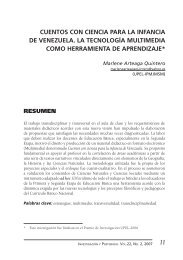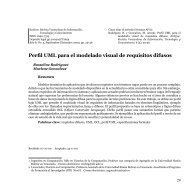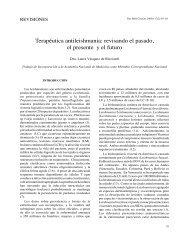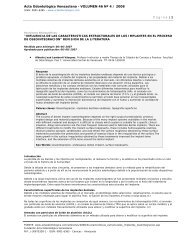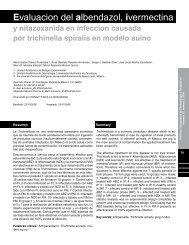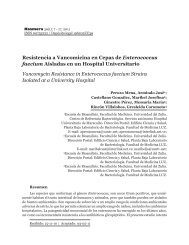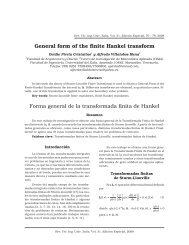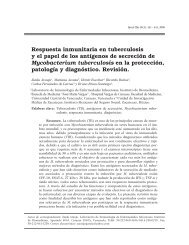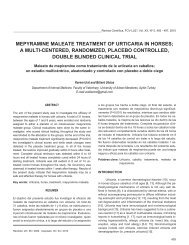Polimorfismos intragénicos de los genes de los factores ... - SciELO
Polimorfismos intragénicos de los genes de los factores ... - SciELO
Polimorfismos intragénicos de los genes de los factores ... - SciELO
You also want an ePaper? Increase the reach of your titles
YUMPU automatically turns print PDFs into web optimized ePapers that Google loves.
<strong>Polimorfismos</strong> <strong>intragénicos</strong> <strong>de</strong> <strong>los</strong> <strong>genes</strong><br />
<strong>de</strong> <strong>los</strong> <strong>factores</strong> VIII y IX y su utilidad<br />
en el diagnóstico indirecto <strong>de</strong> portadoras<br />
<strong>de</strong> Hemofilias A y B.<br />
Lisbeth Borjas 1 , William Zabala 1 , Lennie Pineda 1 , Tatiana Pardo 1 , Erika Fernán<strong>de</strong>z 2 ,<br />
Mariana Zambrano 3 , Jose M. Quintero 1 , Melvis Arteaga-Vizcaíno 2 ,<br />
Alisandra Morales-Machín 1 y Wilmer Delgado 1 .<br />
1Laboratorio <strong>de</strong> Genética Molecular, Unidad <strong>de</strong> Genética,<br />
2Instituto <strong>de</strong> Investigaciones Clínicas “Dr. Américo Negrette” y<br />
3Cátedra <strong>de</strong> Bioquímica Clínica, Facultad <strong>de</strong> Medicina, Universidad <strong>de</strong>l Zulia.<br />
Maracaibo, Venzuela.<br />
Palabras clave: hemofilia A, hemofilia B, portadora, polimorfismos.<br />
Invest Clin 51(3): 391 - 401, 2010<br />
Resumen. Las Hemofilias A y B se consi<strong>de</strong>ran enfermeda<strong>de</strong>s hereditarias<br />
ligadas al sexo <strong>de</strong>bidas a mutaciones en <strong>los</strong> <strong>genes</strong> que codifican para <strong>los</strong> <strong>factores</strong><br />
VIII y IX respectivamente, ocasionando <strong>de</strong>ficiencia en <strong>los</strong> niveles <strong>de</strong> la concentración<br />
plasmática <strong>de</strong> estas proteínas y cuyos roles son <strong>los</strong> <strong>de</strong> participar<br />
activamente en el mecanismo <strong>de</strong> la coagulación sanguínea. Se han reportado<br />
diversas mutaciones responsables <strong>de</strong> la alteración <strong>de</strong> estos <strong>genes</strong>; razón por la<br />
cual resulta poco práctico la aplicación <strong>de</strong> un método <strong>de</strong> diagnóstico molecular<br />
directo para la i<strong>de</strong>ntificación <strong>de</strong> mujeres portadoras, por ello, una estrategia<br />
diagnóstica apropiada es el análisis indirecto <strong>de</strong> polimorfismos ligados al<br />
gen. El objetivo <strong>de</strong> este trabajo fue i<strong>de</strong>ntificar mujeres portadoras en diversas<br />
familias con antece<strong>de</strong>ntes <strong>de</strong> HA y HB resi<strong>de</strong>ntes <strong>de</strong>l estado Zulia, en Venezuela,<br />
caracterizando polimorfismos <strong>intragénicos</strong> <strong>de</strong> <strong>los</strong> <strong>genes</strong> <strong>de</strong>l factor VIII y<br />
factor IX, <strong>los</strong> cuales permitieron asignar haplotipos y diagnosticar o <strong>de</strong>scartar<br />
el estado portador al 95% <strong>de</strong> las mujeres que requerían el estudio para HA y al<br />
100% para HB.<br />
Autor <strong>de</strong> correspon<strong>de</strong>ncia: Lisbeth Borjas. Unidad <strong>de</strong> Genética Médica, Facultad <strong>de</strong> Medicina, Universidad <strong>de</strong>l<br />
Zulia. Maracaibo, Venezuela. Apartado Postal: 15047. Fax: 58-261-7533822. Correo electrónico: lisbethborjas<br />
@gmail.com.
392 Borjas y col.<br />
Intragenic polymorphisms of factor VIII and IX <strong>genes</strong><br />
and their utility in the indirect diagnosis of carriers<br />
of Haemophilias A and B.<br />
Invest Clin 2010; 51(3): 391 - 401<br />
Key words: haemophilia A, haemophilia B, carrier, polymorphisms.<br />
Abstract. Haemophilia A and B are consi<strong>de</strong>red sex-linked inherited diseases<br />
caused by mutations in <strong>genes</strong> that enco<strong>de</strong> factors VIII and IX, respectively.<br />
This results in the <strong>de</strong>ficiency of these proteins plasma levels which are<br />
actively involved in the mechanism of blood coagulation. It has been reported<br />
that several mutations are responsible for the alteration of these <strong>genes</strong>, which<br />
is why the application of a molecular diagnostic method for the direct i<strong>de</strong>ntification<br />
of female carriers is impractical. An appropriate diagnostic strategy is<br />
the indirect analysis of polymorphisms linked to the gene. The aim of this<br />
study was to i<strong>de</strong>ntify female carriers in different families with history of HA<br />
and HB that live in Zulia State, Venezuela, characterizing intragenic gene<br />
polymorphisms of the clotting factors VIII and IX, which helped to i<strong>de</strong>ntify<br />
and assign haplotypes, to diagnose or to exclu<strong>de</strong> the carrying condition, to<br />
95% of women who were needing the study for HA and to 100% for HB.<br />
Recibido: 17-05-2009. Aceptado: 08-04-2010.<br />
INTRODUCCIÓN<br />
Las Hemofilias A y B (HA y HB) son enfermeda<strong>de</strong>s<br />
hereditarias severas, cuyo mecanismo<br />
<strong>de</strong> transmisión es recesivo ligado<br />
al X, con una inci<strong>de</strong>ncia <strong>de</strong> 1 por cada<br />
5.000 a 10.000 varones nacidos vivos (1-3) y<br />
<strong>de</strong> 1 por cada 30.000 a 40.000 respectivamente<br />
(4, 5). Ambas entida<strong>de</strong>s se <strong>de</strong>ben a<br />
<strong>de</strong>fectos en <strong>los</strong> <strong>genes</strong> que codifican para el<br />
FACTOR VIII (FVIII) o FACTOR IX (FIX),<br />
proteínas que intervienen en la serie <strong>de</strong><br />
reacciones que conducen a la coagulación<br />
sanguínea. En ambas enfermeda<strong>de</strong>s la manifestación<br />
clínica principal es el sangrado,<br />
cuya localización en el caso <strong>de</strong> frecuencia y<br />
en la severidad <strong>de</strong>pen<strong>de</strong>rá <strong>de</strong> la actividad<br />
residual <strong>de</strong>l FVIII y <strong>de</strong>l FIX. Por tratarse <strong>de</strong><br />
un trastorno ligado al cromosoma X, la<br />
afectación es generalmente en varones,<br />
aunque se han <strong>de</strong>scrito algunos casos <strong>de</strong><br />
mujeres afectadas (6-8).<br />
El gen que codifica al FVIII se localiza<br />
en el brazo largo <strong>de</strong>l cromosoma X en la región<br />
Xq28, aproximadamente a un Megabase<br />
<strong>de</strong>l telómero (9); tiene una longitud <strong>de</strong><br />
186 Kilobases (Kb), distribuidas en 26 exones<br />
y 25 intrones; ocupa el 0,1% <strong>de</strong>l cromosoma<br />
X (10) y su producto es un péptido <strong>de</strong><br />
2.332 aminoácidos que representan 9 Kb<br />
<strong>de</strong>l total <strong>de</strong>l tamaño <strong>de</strong>l transcripto. El resto,<br />
lo constituyen 177 Kb representadas por<br />
25 intrones, 6 <strong>de</strong> el<strong>los</strong> mi<strong>de</strong>n más <strong>de</strong> 14 Kb<br />
y algunos son <strong>de</strong> hasta 32 Kb. Los exones<br />
14 y 26 contienen 3.106 y 1.958 pares <strong>de</strong><br />
bases (pb) respectivamente, el resto <strong>de</strong> <strong>los</strong><br />
exones varían en longitud entre 69 y 262 pb<br />
(11, 12). El gen que codifica para el FIX<br />
está localizado en el brazo largo <strong>de</strong>l cromosoma<br />
X, en posición proximal al sitio frágil<br />
(gen FMR1), ubicado en la banda Xq 27,3.<br />
Este gen está próximo al gen <strong>de</strong>l FVIII, al<br />
<strong>de</strong>l Daltonismo y al <strong>de</strong> la Glucosa 6 fosfato<br />
<strong>de</strong>shidrogenasa. Posee una longitud <strong>de</strong> 34<br />
Investigación Clínica 51(3): 2010
<strong>Polimorfismos</strong> <strong>de</strong> <strong>los</strong> <strong>genes</strong> <strong>de</strong> <strong>los</strong> <strong>factores</strong> VIII y IX en hemofilia A y B 393<br />
Kb y está compuesto por 8 exones capaces<br />
<strong>de</strong> codificar diferentes dominios en la proteína<br />
<strong>de</strong>l FIX y <strong>de</strong> 7 intrones (13, 14).<br />
Sehaencontradounaampliagama<strong>de</strong><br />
eventos mutacionales en ambos <strong>genes</strong>: <strong>de</strong>leciones,<br />
mutaciones puntuales, inserciones,<br />
inversiones, etc. (15), incluso, cerca<br />
<strong>de</strong>l 50% <strong>de</strong> <strong>los</strong> afectados <strong>de</strong> HA con fenotipo<br />
severo, presenta gran<strong>de</strong>s inversiones en<br />
su secuencias, que pue<strong>de</strong>n ser <strong>de</strong> tipo proximal<br />
o distal, <strong>de</strong>pendiendo <strong>de</strong>l punto <strong>de</strong><br />
ruptura entre la secuencia F8A, ubicada en<br />
el intrón 22 <strong>de</strong>l gen y las ubicadas en el extremo<br />
proximal o distal al locus Xq28 (16).<br />
Cabe <strong>de</strong>stacar a<strong>de</strong>más que para el caso <strong>de</strong><br />
HB, algunos pacientes afectados presentan<br />
gran<strong>de</strong>s <strong>de</strong>leciones que involucran el gen<br />
completo (8).<br />
Debido a la gran heterogeneidad mutacional,<br />
la <strong>de</strong>tección directa <strong>de</strong>l <strong>de</strong>fecto causante<br />
<strong>de</strong> ambos tipos <strong>de</strong> hemofilias, es complicada<br />
a<strong>de</strong>más <strong>de</strong> costosa, lo que dificulta<br />
su aplicación en la i<strong>de</strong>ntificación <strong>de</strong> mujeres<br />
portadoras <strong>de</strong>l gen <strong>de</strong>fectuoso. En vista<br />
<strong>de</strong> ello, se han <strong>de</strong>sarrollado estrategias que<br />
permiten la asignación <strong>de</strong>l estado portador<br />
<strong>de</strong> la enfermedad. Una <strong>de</strong> ellas se basa en el<br />
estudio <strong>de</strong> la segregación familiar <strong>de</strong> polimorfismos<br />
presentes en el ADN, in<strong>de</strong>pendientemente<br />
<strong>de</strong> la naturaleza <strong>de</strong> la mutación<br />
responsable <strong>de</strong> la enfermedad y el objetivo<br />
<strong>de</strong> su uso, es i<strong>de</strong>ntificar al cromosoma<br />
X portador <strong>de</strong>l gen <strong>de</strong>fectuoso, apoyados en<br />
el estudio <strong>de</strong> la genealogia. De esta manera,<br />
es posible establecer el diagnóstico indirecto<br />
molecular tanto <strong>de</strong> portadoras como <strong>de</strong>l<br />
estado <strong>de</strong> afectación <strong>de</strong> nuevos casos familiares<br />
<strong>de</strong> HA y HB.<br />
El objetivo <strong>de</strong>l trabajo es i<strong>de</strong>ntificar<br />
mujeres portadoras a través <strong>de</strong>l análisis indirecto<br />
<strong>de</strong>l polimorfismos en <strong>los</strong> <strong>genes</strong> que<br />
codifican para el FVIII y el FIX en familias<br />
segregantes <strong>de</strong> HA y HB resi<strong>de</strong>ntes en el estado<br />
Zulia, Venezuela.<br />
Vol. 51(3): 391 - 401, 2010<br />
PACIENTES Y MÉTODOS<br />
Se estudiaron 29 y 8 familias resi<strong>de</strong>ntes<br />
<strong>de</strong>l estado Zulia, Venezuela, con antece<strong>de</strong>ntes<br />
<strong>de</strong> HA y HB respectivamente, se<br />
tomó en cuenta como criterio <strong>de</strong> inclusión,<br />
que cada familia presentara más <strong>de</strong> un<br />
miembro afectado <strong>de</strong> HA o HB según el<br />
caso. El diagnóstico <strong>de</strong> HA y HB en <strong>los</strong> individuos<br />
afectados fue realizado previamente<br />
por un hematólogo. Las hermanas y tías<br />
maternas <strong>de</strong> <strong>los</strong> afectados conformaron grupos<br />
<strong>de</strong> 79 y 27 probables portadoras <strong>de</strong> HA<br />
y HB respectivamente. Se incluyeron en el<br />
estudio 84 mujeres no relacionadas genéticamente<br />
y sin antece<strong>de</strong>ntes <strong>de</strong> HA ni HB,<br />
como grupo control para las estimaciones<br />
<strong>de</strong> frecuencias alélicas.<br />
Para la realización <strong>de</strong> este trabajo, se<br />
contó con el consentimiento informado <strong>de</strong><br />
las familias y grupos estudiados así como la<br />
aprobación <strong>de</strong>l Comité <strong>de</strong> Bioética <strong>de</strong> la<br />
institución.<br />
Para todas las muestras, se aisló ADN a<br />
partir <strong>de</strong> 200 µL <strong>de</strong> sangre periférica por la<br />
técnica CTAB/DTAB (17). Para HA, se caracterizaron<br />
tres polimorfismos <strong>intragénicos</strong><br />
<strong>de</strong>l gen <strong>de</strong>l FVIII: a) a partir <strong>de</strong> 500 ng<br />
<strong>de</strong> ADN, se amplificó un fragmento <strong>de</strong> 142<br />
pb ubicado en el intrón 18 el cual contiene<br />
un polimorfismo <strong>de</strong> restricción para la enzima<br />
BclI (rs4898352), con ale<strong>los</strong> <strong>de</strong> 142 y<br />
99+43 pb (18, 19) y se caracterizaron <strong>los</strong><br />
fragmentos mediante una electroforesis en<br />
gel <strong>de</strong> poliacrilamida (PAGE) al 12% en buffer<br />
TBE 1X teñido con bromuro <strong>de</strong> etidio y<br />
visualido con luz UV; b) a partir <strong>de</strong> 250 ng<br />
<strong>de</strong> ADN, se amplificaron simultáneamente<br />
dos polimorfismos <strong>de</strong> longitud ubicados en<br />
<strong>los</strong> intrones 13 y 22 <strong>de</strong>l gen, conocidos<br />
como (CA)n y (GT)n(AG)n respectivamente<br />
(20-23), pero se introdujeron modificaciones<br />
en el programa original <strong>de</strong> la PCR:<br />
94°C,por 5 minutos; 10 cic<strong>los</strong> <strong>de</strong> 94°C,
394 Borjas y col.<br />
52°C y 72°C por un minuto cada paso y <strong>de</strong>spués<br />
25 cic<strong>los</strong> <strong>de</strong> 90°C, 53°C y 72°C por 1<br />
minuto cada paso y una extensión final <strong>de</strong> 5<br />
minutos a 72°C; la caracterización <strong>de</strong> fragmentos<br />
amplificados se realizó a través <strong>de</strong><br />
PAGE al 10% en buffer TBE 1X y la visualización<br />
se hizo con tinción argéntica como<br />
<strong>de</strong>scriben Santos y col. (24). Para conocer<br />
el número <strong>de</strong> ale<strong>los</strong> diferentes <strong>de</strong> estos polimorfsmos<br />
<strong>de</strong> longitud, por cada gel se seleccionaron<br />
<strong>los</strong> ale<strong>los</strong> <strong>de</strong> distintos tamaños<br />
y posteriormente se aplicaron estos productos<br />
reunidos todos en un mismo gel y <strong>de</strong><br />
acuerdo a la posición <strong>de</strong> las bandas observadas,<br />
se nominó el alelo Nº 1 (A 1) como el <strong>de</strong><br />
menor tamaño para ambos polimorfismos,<br />
el alelo Nº 6 (A 6) y alelo Nº 5 (A 5) para <strong>los</strong><br />
ale<strong>los</strong> <strong>de</strong> mayor tamaño para el intrón 13 y<br />
22 respectivamente.<br />
Para <strong>los</strong> polimorfismos <strong>de</strong> HB, se amplificaron<br />
cuatro marcadores <strong>intragénicos</strong><br />
<strong>de</strong>l gen <strong>de</strong>l FIX: a) el polimorfismo HinfI,<br />
ubicado en el intrón 1 <strong>de</strong>l gen que amplifica<br />
directamente fragmentos <strong>de</strong> 325 y 375<br />
pb (4, 25); b) el polimorfismo XMnI<br />
(rs438601), ubicado en el intrón 3 <strong>de</strong>l gen,<br />
generando fragmentos <strong>de</strong> 1.176 y 858+318<br />
pb (5); c) el polimorfismo TaqI (rs398101),<br />
ubicado en el intrón 4 <strong>de</strong>l gen, el cual consiste<br />
en un fragmento amplificado <strong>de</strong> 343<br />
pb con un sitio <strong>de</strong> restricción para la enzima<br />
TaqI que genera fragmentos <strong>de</strong> 343 y<br />
171+172 pb (26); d) el polimorfismo HhaI<br />
(rs3117459), ubicado en el extremo 3’ no<br />
traducible <strong>de</strong>l gen, el cual consiste en amplificar<br />
un fragmento <strong>de</strong> 230 pb y contiene<br />
un sitio <strong>de</strong> restricción para la enzima HhaI,<br />
generando productos <strong>de</strong> 230 y 150+80 pb<br />
(5). La caracterización genotípica <strong>de</strong> <strong>los</strong> 4<br />
polimorfismos <strong>intragénicos</strong> para HB se realizó<br />
a través <strong>de</strong> electroforesis en geles <strong>de</strong><br />
agarosa al 2%, buffer TBE 1X teñidos con<br />
bromuro <strong>de</strong> etidio y visualizada las bandas<br />
con exposición a luz UV.<br />
RESULTADOS<br />
La caracterización <strong>de</strong> <strong>los</strong> polimorfismos<br />
analizados, tres para HA y cuatro para HB,<br />
permitió crear y asignar haplotipos a cada<br />
miembro <strong>de</strong> <strong>los</strong> grupos <strong>de</strong> familias. Los resultados<br />
nos indican que fue posible hacer<br />
diagnóstico o <strong>de</strong>scartar el estado portador<br />
para HA en el 93% <strong>de</strong> las familias (27/29) y<br />
en el 100% para HB (8/8). Se logró i<strong>de</strong>ntificar<br />
a 75 mujeres <strong>de</strong>l grupo <strong>de</strong> las 79 que requerían<br />
el estudio para HA, lo cual representa<br />
el 95% <strong>de</strong> <strong>los</strong> casos, <strong>de</strong> las cuales, 46 resultaron<br />
ser portadoras <strong>de</strong>l gen <strong>de</strong>fectuoso y<br />
29 fueron i<strong>de</strong>ntificadas como no portadoras.<br />
Con respecto a HB, se <strong>de</strong>terminó el diagnóstico<br />
en todas las mujeres que necesitaban el<br />
estudio, i<strong>de</strong>ntificando a 15 <strong>de</strong> ellas como<br />
portadoras <strong>de</strong> HB. Los resultados generales<br />
se indican en la Tabla I. En un grupo <strong>de</strong> cuatro<br />
mujeres no fue posible <strong>de</strong>terminar ni<br />
<strong>de</strong>scartar el diagnóstico <strong>de</strong> portadora HA, ya<br />
que las madres <strong>de</strong> <strong>los</strong> afectados resultaron<br />
ser homocigotas para <strong>los</strong> tres polimorfismos<br />
analizados en el gen <strong>de</strong>l FVIII.<br />
La posibilidad <strong>de</strong> que una familia sea<br />
informativa <strong>de</strong>pen<strong>de</strong>rá que la madre <strong>de</strong>l<br />
afectado sea heterocigota para al menos un<br />
polimorfismo, resultando tener haplotipos<br />
distintos en cada cromosoma X, que al<br />
comparar con su hijo afectado, se podrá<br />
i<strong>de</strong>ntificar al cromosoma X portador <strong>de</strong>l<br />
gen <strong>de</strong>fectuoso, y por consiguiente, se observará<br />
si está o no presente en las probables<br />
portadoras. Por tanto, la informatividad<br />
en términos <strong>de</strong> utilidad diagnóstica en<br />
cada polimorfismo se pue<strong>de</strong> <strong>de</strong>terminar estimando<br />
la probabilidad <strong>de</strong> encontrar mujeres<br />
heterocigotas en la muestra <strong>de</strong> la población<br />
general analizada. Esta probabilidad se<br />
estimó en base a la muestra <strong>de</strong> 84 mujeres<br />
no relacionadas genéticamente para cada<br />
polimorfismo y cuyas frecuencias alélicas y<br />
valores <strong>de</strong> utilidad diagnóstica se presentan<br />
en la Tabla II.<br />
Investigación Clínica 51(3): 2010
<strong>Polimorfismos</strong> <strong>de</strong> <strong>los</strong> <strong>genes</strong> <strong>de</strong> <strong>los</strong> <strong>factores</strong> VIII y IX en hemofilia A y B 395<br />
TABLA I<br />
DISTRIBUCIÓN DE LAS PACIENTES ESTUDIADAS PARA IDENTIFICAR EL ESTADO<br />
DE PORTADORAS DE HA Y HB<br />
Parámetro Hemofilia A Hemofilia B<br />
Afectados 46 11<br />
Portadoras obligadas 41 10<br />
Requieren diagnóstico* 79 27<br />
Portadoras* 46 15<br />
No portadoras* 29 12<br />
Sin conclusión* 4 -<br />
Portadora informativa* 43 15<br />
Madres <strong>de</strong> afectados no informativas*<br />
* Diagnosticadas en el presente trabajo.<br />
2 -<br />
TABLA II<br />
FRECUENCIAS ALÉLICAS Y UTILIDAD DIAGNÓSTICA EN LA MUESTRA CONTROL ANALIZADA,<br />
N:84 MUJERES<br />
Gen <strong>Polimorfismos</strong><br />
Ubicación<br />
FACTOR VIII Bcl I<br />
Intrón 18<br />
(CA)n<br />
Intrón 13<br />
Vol. 51(3): 391 - 401, 2010<br />
(GT)n(AG)n<br />
Intrón 22<br />
FACTOR IX Hinf I<br />
Intrón 1<br />
Xmn I<br />
Intrón 3<br />
Taq I<br />
Intrón 4<br />
Hha I<br />
Extremo 3’<br />
A: Ale<strong>los</strong>; pb: pares <strong>de</strong> base.<br />
Frecuencia alélica Utilidad diagnóstica<br />
(%)<br />
142 pb: 0,32<br />
99+43 pb: 0,68<br />
A 1: 0,09<br />
A 2: 0,18<br />
A 3: 0,32<br />
A 4: 0,27<br />
A 5: 0,05<br />
A 6: 0,09<br />
A 1: 0,05<br />
A 2: 0,05<br />
A 3: 0,27<br />
A 4: 0,36<br />
A 5: 0.27<br />
325 pb: 0,65<br />
375 pb: 0,35<br />
1.176 pb; 0,88<br />
858+318 pb: 0,12<br />
343 pb: 0,48<br />
171+172 pb: 0,52<br />
230 pb: 0,54<br />
150+80 pb: 0,46<br />
44<br />
80<br />
73<br />
46<br />
21<br />
49<br />
50
396 Borjas y col.<br />
La informatividad en <strong>los</strong> polimorfismos<br />
<strong>de</strong> restricción se estimó según la regla <strong>de</strong>l<br />
binomio cuadrado: (p + q) 2 :p 2 + 2pq + q 2<br />
(27), sustituyendo en 2pq las frecuencias<br />
<strong>de</strong> cada alelo para obtener el nivel <strong>de</strong> heterocigosis<br />
esperada.<br />
Para <strong>los</strong> polimorfismos con sistemas<br />
multialélicos, como ocurre en <strong>los</strong> (CA)n y<br />
(GT)n(AG)n, el grado <strong>de</strong> heterocigosis esperada<br />
se estimó con la fórmula: 1 – (p 2 +<br />
q 2 +r 2 ), según Yip y col. (23).<br />
En las Figs. 1 y 2, se muestran genealogías<br />
con antece<strong>de</strong>ntes <strong>de</strong> HA y HB respectivamente,<br />
y don<strong>de</strong> se indican <strong>los</strong> haplotipos<br />
asignados a cada miembro <strong>de</strong>l grupo familiar<br />
y se i<strong>de</strong>ntifican aquellas que resultaron<br />
portadoras o no <strong>de</strong>l gen <strong>de</strong>fectuoso.<br />
DISCUSIÓN<br />
El <strong>de</strong>sarrollo que en las últimas décadas<br />
se ha evi<strong>de</strong>nciado en el campo <strong>de</strong> la<br />
Biología Molecular ha permitido el análisis<br />
I<br />
II<br />
III<br />
A 2<br />
99+43<br />
A 1<br />
A 2<br />
142<br />
A 1<br />
1 2<br />
A 3<br />
142<br />
A 1<br />
<strong>de</strong>tallado <strong>de</strong> <strong>genes</strong> humanos y generan conocimientos<br />
sobre <strong>los</strong> fenómenos moleculares<br />
implicados en la génesis <strong>de</strong> las enfermeda<strong>de</strong>s.<br />
En el caso <strong>de</strong> HA y HB, estos a<strong>de</strong>lantos<br />
han permitido analizar la estructura <strong>de</strong>l<br />
FVIII y FIX respectivamente, logrando en<br />
primer término <strong>de</strong>terminar <strong>los</strong> <strong>de</strong>fectos moleculares<br />
implicados y posteriormente i<strong>de</strong>ntificar<br />
en estos <strong>genes</strong> regiones polimórficas,<br />
<strong>de</strong> consi<strong>de</strong>rable valor para el diagnóstico <strong>de</strong><br />
mujeres portadoras y en algunos casos para<br />
el diagnóstico prenatal (15, 28-31), enriqueciendo<br />
<strong>de</strong> esta manera la práctica <strong>de</strong>l<br />
asesoramiento genético a familias con antece<strong>de</strong>ntes<br />
<strong>de</strong> HA y HB.<br />
La <strong>de</strong>tección oportuna <strong>de</strong> mujeres portadoras<br />
es <strong>de</strong> suma importancia en Genética<br />
Médica; la estrategia tradicional para <strong>de</strong>tectar<br />
portadoras a través <strong>de</strong> pruebas <strong>de</strong><br />
coagulación, resulta sólo útil en familias<br />
con casos esporádicos <strong>de</strong> afectados <strong>de</strong> HA y<br />
HB, a<strong>de</strong>más es un sistema poco a<strong>de</strong>cuado,<br />
la reproducibilidad <strong>de</strong> sus resultados se ve<br />
1 2 3 4 5 6 7<br />
A1 A2 A1 A2 A1 A3 A1 A2 A 2<br />
142 99+43<br />
A1 A1 A 1<br />
142 142<br />
A1 A1 3<br />
A 1<br />
142<br />
A 1<br />
A 1<br />
142<br />
A 1<br />
1<br />
4 5<br />
A2 A2 142 99+43<br />
A1 A1 142 99+43<br />
A1 A1 2<br />
A 2<br />
99+43<br />
A 1<br />
A 2<br />
A 3<br />
99+43 142<br />
A1 A1 142 142<br />
A1 A1 Haplotipo:<br />
(CA)n<br />
Bcl I<br />
(GT)n(AG)n<br />
142 99+43<br />
A1 A1 Fig. 1. Genealogía <strong>de</strong> la familia Nº 17 con antece<strong>de</strong>ntes <strong>de</strong> HA. Se muestran <strong>los</strong> haplotipos <strong>de</strong> <strong>los</strong> polimorfismos<br />
<strong>de</strong> intrones 13, 18 y 22 en cada miembro analizado. I 2 yII 2 son portadoras obligadas.<br />
Dos hermanas (II 4 yII 7) y una hija <strong>de</strong> la madre <strong>de</strong> <strong>los</strong> hermanos afectados (III 5) resultaron<br />
portadoras.<br />
Investigación Clínica 51(3): 2010
<strong>Polimorfismos</strong> <strong>de</strong> <strong>los</strong> <strong>genes</strong> <strong>de</strong> <strong>los</strong> <strong>factores</strong> VIII y IX en hemofilia A y B 397<br />
afectada o <strong>de</strong>pen<strong>de</strong>rá <strong>de</strong> fluctuaciones en la<br />
actividad <strong>de</strong>l factor VIII, <strong>de</strong> la relación<br />
FVIII/FvW en el caso <strong>de</strong> HA, <strong>de</strong>l factor IX,<br />
<strong>de</strong> la activación <strong>de</strong> la cascada <strong>de</strong> coagulación<br />
durante la manipulación <strong>de</strong> la muestra,<br />
y <strong>de</strong> una serie <strong>de</strong> <strong>factores</strong> como edad,<br />
ciclo menstrual, la práctica <strong>de</strong> ejercicios,<br />
procesos inflamatorios, embarazo, fiebre,<br />
diabetes, trastornos <strong>de</strong> la glándula tiroi<strong>de</strong>s<br />
y cirugías, a<strong>de</strong>más el fenómeno <strong>de</strong> inactivación<br />
<strong>de</strong>l cromosoma X origina un amplio espectro<br />
<strong>de</strong> valores, <strong>los</strong> cuales se consi<strong>de</strong>ran<br />
falsamente normales (22, 32-34).<br />
Los polimorfismos <strong>intragénicos</strong> representan<br />
marcadores <strong>de</strong> alto valor para <strong>los</strong> estudios<br />
<strong>de</strong> ligamiento. El porcentaje <strong>de</strong> recombinación<br />
entre <strong>los</strong> marcadores <strong>intragénicos</strong><br />
y el sitio <strong>de</strong> mutación es aproximadamente<br />
<strong>de</strong> 0,01% (9, 28, 35, 36). La posibilidad<br />
<strong>de</strong> proporcionar un diagnóstico erróneo<br />
con el uso <strong>de</strong> <strong>los</strong> polimorfismos en el<br />
Vol. 51(3): 391 - 401, 2010<br />
I<br />
II<br />
III<br />
325<br />
1176<br />
343<br />
230<br />
325 325<br />
1176 1176<br />
343 343<br />
230 150+80<br />
1 2 3 4 5<br />
1 2 3<br />
325 375<br />
1176 1176<br />
343 343<br />
230 230<br />
375<br />
1176<br />
343<br />
230<br />
375 325<br />
1176 1176<br />
343 343<br />
230 150+80<br />
325 325<br />
1176 1176<br />
343 343<br />
230 150+80<br />
1 2<br />
325<br />
1176<br />
343<br />
150+80<br />
325<br />
1176<br />
343<br />
230<br />
Haplotipo:<br />
Hinf I<br />
Xmn I<br />
Taq I<br />
Hha I<br />
Fig. 2. Genealogía <strong>de</strong> familia Nº 6 con antece<strong>de</strong>ntes <strong>de</strong> HB. Se muestran <strong>los</strong> haplotipos <strong>de</strong> <strong>los</strong> intrones<br />
1, 3, 4 y extremo 3’ <strong>de</strong>l gen <strong>de</strong>l FIX en cada miembro analizado. La hermana <strong>de</strong> <strong>los</strong> afectados<br />
(II 2) resultó ser portadora ya que posee el mismo haplotipo materno presente en el afectado<br />
(II 4), y dos <strong>de</strong> sus hijas resultaron igualmente portadoras.<br />
ADN queda limitada a la probabilidad <strong>de</strong> recombinación<br />
entre el sitio polimórfico asociado<br />
al gen anormal y el sitio <strong>de</strong> la mutación,<br />
evento poco probable dado que <strong>los</strong><br />
marcadores analizados están ubicados en el<br />
interior <strong>de</strong>l gen sujeto a estudio. La principal<br />
<strong>de</strong>sventaja <strong>de</strong>l análisis indirecto a través<br />
<strong>de</strong> polimorfismos en la i<strong>de</strong>ntification <strong>de</strong><br />
mujeres portadoras, es en primer lugar, su<br />
incompetencia para casos esporádicos, don<strong>de</strong><br />
habría que <strong>de</strong>tectar el tipo <strong>de</strong> mutación<br />
presente en el paciente afectado y <strong>de</strong>sarrollar<br />
estrategias diagnósticas para las potenciales<br />
portadoras <strong>de</strong>l grupo familiar; otra<br />
<strong>de</strong>sventaja es la necesidad <strong>de</strong> analizar<br />
miembros clave, que pue<strong>de</strong>n no estar disponibles<br />
para el estudio.<br />
Por otra parte, <strong>de</strong>bido a la amplia variedad<br />
con respecto al tipo, número y ubicación<br />
<strong>de</strong> mutaciones reportadas en ambos<br />
<strong>genes</strong> (37-41), se hace necesario implemen-
398 Borjas y col.<br />
tar estrategias prácticas para el diagnóstico<br />
molecular <strong>de</strong> portadoras <strong>de</strong> HA y HB.<br />
Excepto <strong>los</strong> casos esporádicos, una <strong>de</strong> las<br />
estrategias es la <strong>de</strong>tección indirecta a través<br />
<strong>de</strong>l análisis <strong>de</strong> polimorfismos en el ADN.<br />
En HA, el polimorfismo intragénico BclI, ha<br />
sido uno <strong>de</strong> <strong>los</strong> más utilizados para i<strong>de</strong>ntificar<br />
portadoras (42, 43), su utilidad diagnóstica<br />
se ha <strong>de</strong>terminado en distintas poblaciones,<br />
encontrándose alre<strong>de</strong>dor <strong>de</strong>l 42%<br />
(15, 19, 44, 45). En esta investigación, la<br />
utilidad esperada se estimó en 44% y la observada<br />
en 43% y en combinación con el<br />
resto <strong>de</strong> <strong>los</strong> polimorfismos se mostró en un<br />
95%. Al analizar solo el polimorfismo BclI,<br />
en 59% <strong>de</strong> las familias (17/29) había sido<br />
posible i<strong>de</strong>ntificar las portadoras <strong>de</strong> HA,<br />
mientras que con la incorporación <strong>de</strong>l análisis<br />
<strong>de</strong> <strong>los</strong> intrones 13 y 22 <strong>de</strong>l gen, el po<strong>de</strong>r<br />
diagnóstico se vio incrementado por la<br />
creación <strong>de</strong> <strong>los</strong> haplotipos, logrando establecer<br />
el diagnóstico en el 93% <strong>de</strong> las<br />
familias (27/29).<br />
La utilidad diagnóstica esperada para<br />
el polimorfismo (CA)n se estimó en 80% y<br />
para el (GT)n(AG)n en 73%, mientras que<br />
la observada fue 81% y 75% respectivamente.<br />
En la población caucásica la informatividad<br />
resultó más útil que en la presente<br />
muestra, 91% para el marcador (CA)n y menos<br />
útil con 33% para el polimorfismo<br />
(GT)n(AG)n (20-22). En poblaciones <strong>de</strong><br />
China y <strong>de</strong> Turquía se han señalado valores<br />
alre<strong>de</strong>dor <strong>de</strong> 53% para el (CA)n y <strong>de</strong> 50%<br />
para el (GT)n(AG)n (23, 46).<br />
Con respecto a la i<strong>de</strong>ntificación <strong>de</strong><br />
portadoras <strong>de</strong> HB a través <strong>de</strong> cuatro polimorfismos<br />
<strong>intragénicos</strong>, se inició el análisis<br />
con el polimorfismo HinfI, el cual mostró<br />
un nivel <strong>de</strong> heterocigosis esperado <strong>de</strong> 46% y<br />
observado <strong>de</strong> 43%, cifra mayor a las reportadas<br />
en grupos caucásicos con 36% (4). El<br />
polimorfismo XmnI, resultó poco útil en<br />
nuestro estudio, con un 21% y 23% <strong>de</strong> heterocigosis<br />
esperada y observada respectivamente,<br />
cifras inferiores al comparar con po-<br />
blación caucásica que mostró niveles <strong>de</strong><br />
41% (4). En cuanto al polimorfismo TaqI, la<br />
utilidad diagnóstica esperada se estimó en<br />
49% y observada en 45%, siendo esta misma<br />
informatividad indicada para población caucásica<br />
(4). El marcador HhaI fue el último<br />
polimorfismo investigado y con su incorporación<br />
a la batería <strong>de</strong> polimorfismos para<br />
HB, fue posible completar la lista <strong>de</strong> mujeres<br />
que requerían el estudio para su i<strong>de</strong>ntificación;<br />
la heterocigosis esperada y observada<br />
se estimó en 50%, tal como se señala<br />
para poblaciones caucásicas (4, 25, 47).<br />
Los resultados en ambos <strong>genes</strong> constituyen<br />
<strong>los</strong> primeros datos haplotípicos investigados<br />
en población venezolana. En este<br />
trabajo, el análisis permitió no sólo i<strong>de</strong>ntificar<br />
a mujeres libres <strong>de</strong> portar el gen mutado<br />
<strong>de</strong> HA y HB, sino que 93% <strong>de</strong> las mujeres<br />
i<strong>de</strong>ntificadas como portadoras <strong>de</strong> HA y HB<br />
(43/46) y (14/15) respectivamente, resultó<br />
tener genotipo <strong>de</strong> heterocigota, por tanto<br />
estas mujeres son informativas, esto significa<br />
una importante condición para el asesoramiento<br />
genético efectivo a grupos <strong>de</strong> mujeres<br />
con riesgo <strong>de</strong> trasmitir el gen <strong>de</strong>fectuoso<br />
a su <strong>de</strong>scen<strong>de</strong>ncia y hace posible la<br />
aplicación <strong>de</strong>l diagnóstico prenatal para <strong>los</strong><br />
nuevos casos <strong>de</strong> cada familia, in<strong>de</strong>pendientemente<br />
<strong>de</strong> la naturaleza <strong>de</strong> la mutación<br />
que se esta segregando en el grupo familiar.<br />
Ante la limitante <strong>de</strong> no po<strong>de</strong>r i<strong>de</strong>ntificar<br />
en algunas mujeres el estado portador<br />
<strong>de</strong> HA por la no informatividad en <strong>los</strong> marcadores<br />
analizados, se hace necesario incorporar<br />
nuevos marcadores a este estudio,<br />
con la finalidad <strong>de</strong> i<strong>de</strong>ntificar el cromosoma<br />
X ligado a la HA en todas las mujeres <strong>de</strong> las<br />
familias analizadas.<br />
REFERENCIAS<br />
1. Kazazian H, Tud<strong>de</strong>nham E, Antonarakis<br />
S. Hemophilia A and Parahemophilia:<br />
Deficiencies of Coagulation Factors VIII<br />
and V. En: Scriver, The Metabolic and Mo-<br />
Investigación Clínica 51(3): 2010
<strong>Polimorfismos</strong> <strong>de</strong> <strong>los</strong> <strong>genes</strong> <strong>de</strong> <strong>los</strong> <strong>factores</strong> VIII y IX en hemofilia A y B 399<br />
lecular Bases of Inherited Disease. Seventh<br />
edition, 1994: 3241-3267.<br />
2. Gitschier J, Wood W, Goralka T, Wion K,<br />
Chen E, Eaton D, Vehar G, Capon D,<br />
Lawn R. Caracterization of the human factor<br />
VIII gene.Nature 1984; 312:326-330.<br />
3. Gitschier J, Drayna D, Tud<strong>de</strong>nham EG,<br />
White RL, Law RM. Genetic mapping and<br />
diagnosis of haemophilia A achieved<br />
through a Bcl I polymorphism in the factor<br />
VIII gene. Nature 1985; 314:738-740.<br />
4. Winship P, Anson D, Rizza C, Brownlee<br />
G. Carrier <strong>de</strong>tection in haemophilia B using<br />
two further intragenic restriction fragment<br />
length polymorphisms. Nucleic Acids<br />
Res 1984; 12(23):8861-8872.<br />
5. Winship P. Detection of polymorphism at<br />
cytosine phosphoguanadine dinucleoti<strong>de</strong>s<br />
and diagnosis of Haemophilia B. Lancet<br />
1989: 631-633.<br />
6. Migeon B, McGinniss M, Antonarakis S,<br />
Axelman J. Severe Hemophilia A in a female<br />
by criptic translocation: Or<strong>de</strong>r and<br />
orientation of factor VIII within Xq28.<br />
Genomics 1993; 16:20-25.<br />
7. Scho<strong>de</strong>r W. Haemophilia B in female twins<br />
caused by a point mutation in one factor<br />
IX gene and nonrandom inactivation patterns<br />
of the X chromosomes. Thromb<br />
Haemost 1997; 78:1347-1351.<br />
8. Venceslá A, Fuentes-Prior P, Baena M,<br />
Quintana M, Baiget M, Tizzano EF. Severe<br />
haemophilia A in a female resulting<br />
from an inherited gross <strong>de</strong>letion and a <strong>de</strong><br />
novo codon <strong>de</strong>letion in the F8 gene.<br />
Haemophilia 2008; 14:1094-1098.<br />
9. Kazazian H. The molecular basis of hemophilia<br />
A and the present status of carrier<br />
and antenatal diagnosis of the disease.<br />
Thromb Haemost 1993; 70(1):60-62.<br />
10. White G, Shoemaker C. Factor VIII gene<br />
and hemophilia A. Blood 1989; 73 (1):1-<br />
12.<br />
11. Antonarakis S, Kazazian H. The molecular<br />
basis of hemophilia A (factor VIII <strong>de</strong>ficiency)<br />
in man. Progress report from the<br />
Johns Hopkins University. Hemophilia Project.<br />
Recent Adv Hemophil Care 1990; 1-11.<br />
12. Vehar G, Lawn R, Tud<strong>de</strong>nham E, Wood<br />
W. Factor VIII and Factor V. Biochemistry<br />
and pathophysiology. En Scriver, The in-<br />
Vol. 51(3): 391 - 401, 2010<br />
herited basis of metabolic disease. 1994.<br />
Seventh edition. 3: 3241-3267.<br />
13. Antonarakis S. The molecular genetics of<br />
hemophilia A and B in man. Genetics Unit<br />
1987; 27-55.<br />
14. Shu Whan L. Genetic basis and carrier <strong>de</strong>tection<br />
of hemophilia B of chinese origin.<br />
Thomb Haemost 1993; 69(3):247-252.<br />
15. Antonarakis S, Carpenter R, Hoyer L,<br />
Toole J, Copeland K., Carta C, Caskey T,<br />
Kazazian H. Prenatal diagnosis of haemophilia<br />
A by factor VIII gene analysis. Lancet<br />
1985; 22:1407-1409.<br />
16. Lakich D, Kazazian HH, Antonarakis SE,<br />
Gitschier J. Inversions disrupting the factor<br />
VIII gene are a common cause of severe<br />
haemophilia A. Nat Genet 1993; 59:<br />
236-241.<br />
17. Gustincich S, Carminci P, Del Sal G,<br />
Mamfiolelli G, Schnei<strong>de</strong>r C. A fast<br />
method for high-quality genomic DNA extraction<br />
from whole human blood. Biotechniques<br />
1991; 11:300-302.<br />
18. Kogan S, Doherty M, Gitschier J. An improved<br />
method of prenatal diagnosis of genetics<br />
diseases by analysis of amplified<br />
DNA sequences. Application to Hemophilia<br />
A. N Eng J Med 1987; 317:985-990.<br />
19. Borjas-Fajardo L, Pineda L, Arteaga-Vizcaino<br />
M, Morales-Machin A, Delgado W y<br />
Martinez MC. Análisis <strong>de</strong>l polimorfismo<br />
Bcl I <strong>de</strong>l gen <strong>de</strong>l factor VIII en el diagnóstico<br />
molecular <strong>de</strong> portadoras <strong>de</strong> Hemophilia<br />
A en familias <strong>de</strong>l norocci<strong>de</strong>nte <strong>de</strong> Venezuela.<br />
Sangre 1999; 44(1): 19-23.<br />
20. Lalloz MR, McVey JH, Pattinson JK,<br />
Tud<strong>de</strong>nham EG. Haemophilia A diagnosis<br />
by analysis of a hypervariable dinucleoti<strong>de</strong><br />
repeat whithin the factor VIII gene. Lancet<br />
1991; 338:207-211.<br />
21. Lalloz MR, Schwaab R, McVey JH,<br />
Michaeli<strong>de</strong>s K, Tud<strong>de</strong>nham EG. Haemophilia<br />
A diagnosis by simultaneous analysis<br />
of two variable dinucleoti<strong>de</strong> tan<strong>de</strong>m repeats<br />
within the factor VIII gene.Br J<br />
Haematol 1994; 86:804-809.<br />
22. Windsor S, Taylor S, Lillicrap D. Multiplex<br />
analysis of two intragenic micro satellite<br />
repeat polymorphisms in the genetic<br />
diagnosis of haemophilia A. Br J Haematol<br />
1994; 86:810-815.
400 Borjas y col.<br />
23. Yip B, Chan V, Chan TK. Intragenic<br />
dinucleoti<strong>de</strong> repeats in factor VIII gene for<br />
the diagnosis of haemophilia A. Br J<br />
Haematol 1994; 88:889-891.<br />
24. Santos F, Peña S, Epplen J. Genetic and<br />
population study of a Y-linked tetranucleoti<strong>de</strong><br />
repeat DNA polymorphism with<br />
a simple non-isotopic technique. Hum<br />
Genet 1993; 90:655-656.<br />
25. Koeberl D, Bottema C, Ketterling R,<br />
Bridge P, Lillicrap D, Sommer S. Mutations<br />
causing hemophilia B: Direct estimate<br />
of the un<strong>de</strong>rlying rates of spontaneos<br />
germ-line transitions, transversions and<br />
<strong>de</strong>letions in a human gene. Am J Med<br />
Genet 1990; 47:202-217.<br />
26. Camerino G, Grzeschik KH, Jaye M, De<br />
La Salle H, Tolstoshev P, Lecocp JP,<br />
Heilig R, Man<strong>de</strong>l JL. Regional localization<br />
on the human X chromosome and polymorphism<br />
of the coagulation factor IX<br />
gene (Hemofilia B locus). Proc Natl Acad<br />
Sci USA 1984; 81:498-502.<br />
27. Wentworth G, Smith DE. Elementos <strong>de</strong><br />
Algebra, 2a edición Ginn & Co. (ed.).<br />
1917. pp. 456.<br />
28. Aseev M, Surin V, Baboev N, Gornostaeva<br />
T, Kuznetzova T, Kascheeva I. Allelle<br />
frecuencies and molecular diagnosis in<br />
haemophilia A and B patients from Russia<br />
and some Asian Republics of the former<br />
USSR. Prenat Diagn 1994; 14:513-522.<br />
29. Cappello N, Restagro G, Garnerone S,<br />
Gennaro C, Perugini L, Rendine S, Piazza<br />
A, Carbonara A. Carrier <strong>de</strong>tection for prenatal<br />
diagnosis of hemophilia A in Italian<br />
families.Haematologia 1992; 77:302-306.<br />
30. Clark A.The use of multiple restricction<br />
fragment lenght polymorphism in prenatal<br />
risk estimation.Am J Hum Genet 1985;<br />
37:60-72.<br />
31. Morales A, Borjas L, Zabala W, Alvarez F,<br />
Fernán<strong>de</strong>z E, Zambrano M, Delgado W,<br />
Hernán<strong>de</strong>z M, Solis E y Chacín J.<br />
Diagnóstico prenatal molecular indirecto<br />
<strong>de</strong> Hemofilia A y B. Invest Clin 2008;<br />
49(3):289-297.<br />
32. Mandalaky T. Genetics assesment and carriers<br />
<strong>de</strong>tection of haemophilia. Rev<br />
Iberoam Tromb Hemost 1995; 8(3):21-22.<br />
33. Naylor JA, Buck D, Green PM, Willianson<br />
H, Bentley D, Giannelli F. Investigaion of<br />
the <strong>de</strong>fect and the associated inversion<br />
junctions.Hum Mol Genet 1995; 4:1217-<br />
1224.<br />
34. Rivera J, Rojas A, Charles G, Barrera H.<br />
Analisis <strong>de</strong> la Hemofilia A en familias <strong>de</strong>l<br />
noreste <strong>de</strong> Mexico. Rev Invest Clin 1993;<br />
45:23-28.<br />
35. Kochhan L, Lalloz M, Ol<strong>de</strong>rburg J, McVey<br />
J, Olek K, Brackmann H, Tud<strong>de</strong>nham E,<br />
Schwaab R. Haemophilia A diagnosis by<br />
automated fluorescent DNA <strong>de</strong>tection of<br />
ten factor VIII intron 13 dinucleoti<strong>de</strong> repeat<br />
alleles. Blood Coagul Fibrinolysis<br />
1994; 5(4):497-501.<br />
36. Barrai I. Introduzione alla Genetica di<br />
Popolazioni. Appendice. By ISEDI Instituto<br />
Editoriale Internazionale. Via Paleocapa,<br />
6-20121 Milano. Prima Edizione: Ottobre<br />
1978:265-268.<br />
37. Antonarakis S. and a consortium of more<br />
than 50 international authors. Factor VIII<br />
gene inversions in severe haemophilia A:<br />
results of an international consortium<br />
study. Blood 1995; 86:2206-2212.<br />
38. Gitschier J, Kogan S, Sevinson B,<br />
Tud<strong>de</strong>nham EGD. Mutations of factor VIII<br />
clevage sites in hemophilia A. Blood 1988;<br />
72:1022-1028.<br />
39. Green PM, Giannelli F. Hemophia B: Database<br />
of point mutations, short additions<br />
and <strong>de</strong>letions. Nucleic Acids Res 1999;<br />
27(1) (Abstract).<br />
40. Pattinson JK, Millar DS, McVey JH,<br />
Grundy CB, Wieland K, Mibashan RS,<br />
Martinowitz U, Tan Un K, Vidaun M,<br />
Goossens M, Sampietro M, Mannucci PM,<br />
Krawczac M, Reiss J, Zoll B, Myne EE,<br />
Schwartz M, Green PJ, Kakkar VV,<br />
Tud<strong>de</strong>nham EGD, Cooper DN. The molecular<br />
genetic analysis of hemophilia A: a directed<br />
search strategy for the <strong>de</strong>tection of<br />
point mutations in the human factor VIII<br />
gene. Blood 1990; 76:2242-2248.<br />
41. Tud<strong>de</strong>nham EG, Schwaab R, Seehafer J,<br />
Millar DS, Gitschier J, Higuchi M,<br />
Bidichandani S, Connor JM, Hoyer LW,<br />
Yoshioka A, Peake IR, Olek K, Kazazian<br />
HH, Lavergne JM, Giannelli F,<br />
Investigación Clínica 51(3): 2010
<strong>Polimorfismos</strong> <strong>de</strong> <strong>los</strong> <strong>genes</strong> <strong>de</strong> <strong>los</strong> <strong>factores</strong> VIII y IX en hemofilia A y B 401<br />
Antonarakis SE, Cooper DN. Haemophilia<br />
A: database of nucleoti<strong>de</strong> substitutions,<br />
<strong>de</strong>letions, insertions and rearrangements<br />
of the factor VIII gene, second edition. Nucleic<br />
Acids Res 1994; 22:4851-4868.<br />
42. Antonarakis SE, Youssoufian H, Kazazian<br />
HA..Molecular Genetics of Haemophilia A<br />
in man (Factor VIII <strong>de</strong>ficiency). Mol Biol<br />
Med 1987; 4:81-94.<br />
43. Srinivasan A, Mukhopadhyay S, Ahmad Z,<br />
Gupta R, Gupta A, Wadhawan V, Shukla<br />
J, Singh V, Dash D. Factor VIII gene polymorphisms<br />
in North Indian population: a<br />
consensus algorithm for carrier analysis of<br />
hemophilia A. Clin Chim Acta. 2000;<br />
325(1-2):177-181.<br />
44. Antonarakis SE, Waber P.G., Kittur S.D.<br />
Hemophilia A: Molecular <strong>de</strong>fects and car-<br />
Vol. 51(3): 391 - 401, 2010<br />
rier <strong>de</strong>tection by DNA analysis. N Engl J<br />
Med 1985; 313:842-848.<br />
45. Herrmann FH., Wehnert M, Wulff K.<br />
RFLPs analysis for diagnosis of haemophilia<br />
A in the German Democrátic Republic<br />
Clín Genet 1990; 37:12-17.<br />
46. Jarjanazi H, Anil TA, El-Maarri O, Han<strong>de</strong><br />
CS. Analysis of the two microsatellite repeat<br />
polymorphims of the factor VIII gene<br />
in the Turkish population. Br J Haematol<br />
1998; 100:589-593.<br />
47. Tagariello G, Belvini D, Salviato R, Are A,<br />
De Biasi E, Goo<strong>de</strong>ve A, Davoli P. Experience<br />
of a single Italian center in genetic<br />
counseling for hemophilia: from linkage<br />
analysis to molecular diagnosis.<br />
Haematologica 2000; 85(5):525-529.




